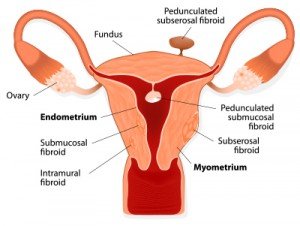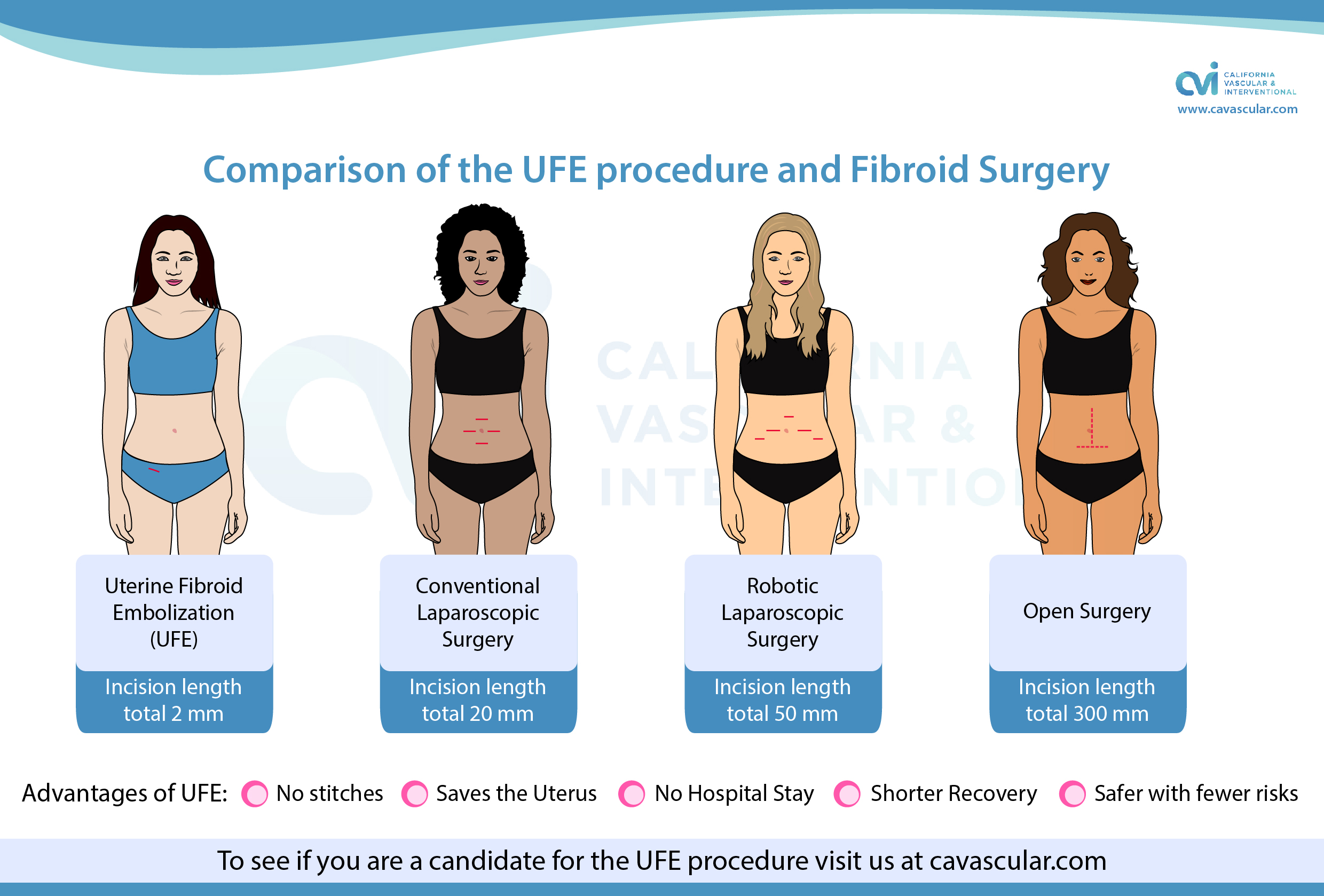Uterine fibroid embolization UFE is a minimally invasive outpatient procedure that is highly effective for treating uterine fibroids and adenomyosis while preserving the uterusUnder conscious sedation UFE begins with a single nick in the arm or groin about 02 cm long. Outcomes of a myomectomy vs a UFE are dependent on the size of the fibroids and their location in the uterus.

Myomectomy Vs Hysterectomy Vs Ufe Which Is Best Dr Lalezarian Explains
Myomectomy remains controversial and uterine artery embolization is proving.

. The success of myomectomy is less certain since no randomized trials against expectant management have ever been carried out. When it comes to a hysterectomy vs. Most women are back to normal activities within only one to two weeks with no stitches or scarring involved.
The cost-effectiveness of UFE comes from the treatment procedure itself. But before you decide which is right for you its important to understand the benefits and drawbacks of each treatment. A slim flexible tube called a catheter is inserted and guided to the uterine.
A hysterectomy typically requires an average of more than 2 days in the hospital and a 2-6 week recovery period much longer than the recovery for UFE. VISUAL ABSTRACT Uterine-Artery Embolization or Myomectomy for Uterine Fibroids. Experience with UFE is limited to the past 10 years but many cases have been described in the literature.
To 100 indicat ing the best pos sible. Myomectomy vs Hysterectomy. There is some dispute about which of these treatments provide the best outcome especially with regard to recurring fibroids and if the patients will eventually require a hysterectomy.
Myomectomy and hysterectomy are both surgical procedures to treat uterine fibroids. The majority of patients declared being very satisfied about the received treatment. UFE is not a surgical operation.
Myomectomy can also be achieved hysteroscopically. Sifting through treatment options youve decided you want a procedure that allows you to keep your uterus. Which Treatment is Best for you.
It is impossible for myomectomy to remove all the fibroids you have. 78 of the uterine artery embolization group vs 87 in the hysterectomy group. Uterine Fibroid Embolization UFE involves less pain fewer risks and a shorter recovery.
A hysterectomy is often associated with a long recovery intense pain menopause or loss of femininity when in reality your uterus doesnt control your hormones whatsoever. It is done through an incision or in some cases more than one incision in the abdomen laparoscopically or hysteroscopically through the vagina and cervix. Uterine-artery embolization emerged as.
Id like to do a myomectomy instead of a hysterectomy but my doctor seems to feel that the recovery is easier with the. I have a large fibroid that is causing me a lot of discomfort. Posted July 20 2016.
There is some dispute about which of these treatments provide the best outcome especially with regard to recurring fibroids and if the patients will eventually require a hysterectomy. A myomectomy procedure is designed to preserve the uterus. Surgery either myomectomy or hysterectomy has traditionally been the primary approach for the management of symptomatic fibroids.
Hysterectomy is the removal of the uterus even if its called partial hysterectomy or total hysterectomy. This minimally-invasive technique allows you to go home the same day as your procedure. A hysterectomy can be partial where only your uterus and cervix are removed or complete which involves the removal of your uterus cervix tubes and ovaries.
Uterine fibroid embolization UFE is a new technique for treating the symptoms of uterine fibroids that avoids hysterectomy or myomectomy. UFE also offers fewer postprocedural complications according to another study. A myomectomy is another uterus-sparing treatment option where the fibroid tumors are cute up typically with a morcellator and removed from the uterus.
In about two thirds of uterine artery embolization-treated patients with symptomatic uterine fibroids a hysterectomy can be avoided. Uterine Fibroid Embolization is less invasive and more affordable. Outcomes of a myomectomy vs a UFE are dependent on the size of the fibroids and their location in the uterus.
Myomectomy is the removal of one or many fibroids at the same time. I am 52 but not menopausal. Either myomectomy or hysterectomy.
A minimally invasive procedure called uterine fibroid embolization UFE was as effective as the recommended surgery for treating fibroids in the uterus a study says. The success of myomectomy is less certain since no randomized trials against expectant management have ever been carried out. Uterine Fibroid Embolization UFE and myomectomy are both effective uterine-sparing options.
Health-related quality of life 10 years after uterine artery. Hysterectomy is associated with a high rate of satisfaction and is likely to relieve menstrual problems in virtually all women. Hysterectomy remains a valuable option in some women but has its drawbacks.
In a myomectomy the fibroids are removed but the healthy parts of the uterus are preserved. In addition myomectomy may lead to adhesion formation within the abdominal cavity which. Small fibroids are ready to take over the blood supply diverted from the first surgical myomectomy.
Myomectomy surgery is not a permanent or guaranteed cure for fibroids as new fibroids can develop in the healthy uterine tissue that a myomectomy leaves intact. Two of the most common surgical treatment options are myomectomy and hysterectomy. One of the primary considerations when youre deciding between a myomectomy and a hysterectomy is whether you wish to remain fertile.
There are different treatment options for fibroids surgical options require larger incisions and carry different risks than fibroid embolization. Below is a brief description of myomectomy surgery hysterectomy surgery and fibroid embolization. Hysterectomy is associated with a high rate of satisfaction and is likely to relieve menstrual problems in virtually all women.
The term hysterectomy refers to removal of ONLY the. In Informational Articles 0. A hysterectomy or removal of the uterus is actually less invasive than a myomectomy and is the only cure for fibroids.
Myomectomy vs Hysterectomy vs Fibroid Embolization Scars.

Uterine Artery Embolization Versus Hysterectomy In The Treatment Of Symptomatic Uterine Fibroids 2 Years Outcome From The Randomized Emmy Trial American Journal Of Obstetrics Gynecology

Fibroid Embolization Vs Hysterectomy Surgery

Scars Ufe Vs Myomectomy Vs Hysterectomy Los Angeles Fibroid Center

2 Comments
There are different treatment options for fibroids, surgical options require larger incisions and carry different risks than fibroid embolization. Below is a brief description of myomectomy surgery, hysterectomy surgery and fibroid embolization. A hysterectomy is a major surgical procedure performed in the hospital or surgery center under general anesthesia. The doctor may also remove the fallopian tubes, ovaries and/or the cervix during the same surgery.
ReplyDeleteThis was a really helpful read! I've just been investigating fibroid treatment options, and your summary of embolisation, myomectomy, and hysterectomy truly helped me comprehend the benefits and drawbacks. Do you have any firsthand experiences or testimonials from persons who have had these procedures performed on them?
ReplyDelete